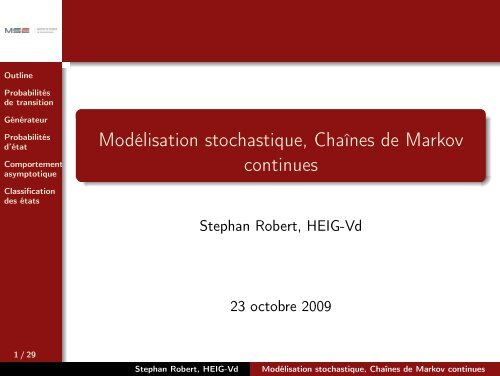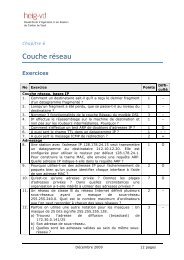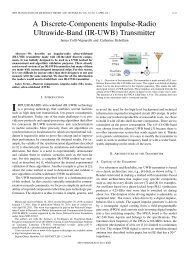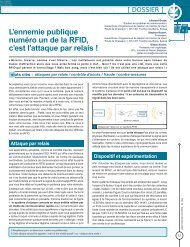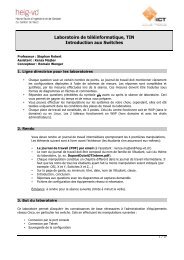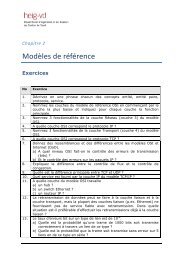Modélisation stochastique, Chaînes de Markov continues
Modélisation stochastique, Chaînes de Markov continues
Modélisation stochastique, Chaînes de Markov continues
You also want an ePaper? Increase the reach of your titles
YUMPU automatically turns print PDFs into web optimized ePapers that Google loves.
Outline<br />
Probabilités<br />
<strong>de</strong> transition<br />
Générateur<br />
Probabilités<br />
d’état<br />
Comportement<br />
asymptotique<br />
Modélisation <strong>stochastique</strong>, Chaînes <strong>de</strong> <strong>Markov</strong><br />
<strong>continues</strong><br />
Classification<br />
<strong>de</strong>s états<br />
Stephan Robert, HEIG-Vd<br />
23 octobre 2009<br />
1 / 29<br />
Stephan Robert, HEIG-Vd<br />
Modélisation <strong>stochastique</strong>, Chaînes <strong>de</strong> <strong>Markov</strong> <strong>continues</strong>
Outline<br />
Probabilités<br />
<strong>de</strong> transition<br />
Générateur<br />
Probabilités<br />
d’état<br />
Comportement<br />
asymptotique<br />
Classification<br />
<strong>de</strong>s états<br />
1 Probabilités <strong>de</strong> transition<br />
2 Générateur<br />
3 Probabilités d’état<br />
4 Comportement asymptotique<br />
5 Classification <strong>de</strong>s états<br />
2 / 29<br />
Stephan Robert, HEIG-Vd<br />
Modélisation <strong>stochastique</strong>, Chaînes <strong>de</strong> <strong>Markov</strong> <strong>continues</strong>
Outline<br />
Probabilités<br />
<strong>de</strong> transition<br />
Générateur<br />
Probabilités<br />
d’état<br />
Comportement<br />
asymptotique<br />
Classification<br />
<strong>de</strong>s états<br />
Probabilités <strong>de</strong> transition<br />
3 / 29<br />
Stephan Robert, HEIG-Vd<br />
Modélisation <strong>stochastique</strong>, Chaînes <strong>de</strong> <strong>Markov</strong> <strong>continues</strong>
Introduction<br />
Outline<br />
Probabilités<br />
<strong>de</strong> transition<br />
Générateur<br />
Probabilités<br />
d’état<br />
Comportement<br />
asymptotique<br />
Classification<br />
<strong>de</strong>s états<br />
{X n } : suite <strong>de</strong> variables aléatoires prenant <strong>de</strong>s valeurs<br />
dans E = {0, 1, 2, . . . , m}, E dénombrable.<br />
La probabilité <strong>de</strong> transition d’un état (i) à l’instant t à un<br />
autre état (j) à l’instant t + τ ne dépend que <strong>de</strong> la<br />
différence <strong>de</strong> temps τ :<br />
Processus homogène :<br />
P (X t+τ = j|X t = i) = p ij (τ)<br />
P (X t+τ = j|X(t) = i) = P (X τ = j|X 0 = i) = p ij (τ)<br />
4 / 29<br />
Stephan Robert, HEIG-Vd<br />
Modélisation <strong>stochastique</strong>, Chaînes <strong>de</strong> <strong>Markov</strong> <strong>continues</strong>
Probabilités <strong>de</strong> transition<br />
Outline<br />
Probabilités<br />
<strong>de</strong> transition<br />
Générateur<br />
Probabilités<br />
d’état<br />
Comportement<br />
asymptotique<br />
Classification<br />
<strong>de</strong>s états<br />
Matrice <strong>de</strong> transition :<br />
⎛<br />
P(t) =<br />
⎜<br />
⎝<br />
p 00 (t) p 01 (t) ... p 0m (t)<br />
p 10 (t) p 11 (t) ... p 1m (t)<br />
... ... ... . . .<br />
p m0 (t) p n1 (t) ... p mm (t)<br />
⎞<br />
⎟<br />
⎠<br />
Remarque :<br />
⎛<br />
P(0) =<br />
⎜<br />
⎝<br />
p 00 (0) = 1 p 01 (0) = 0 ... p 0m (0) = 0<br />
p 10 (0) = 0 p 11 (0) = 1 ... p 1m (0) = 0<br />
... ... ... . . .<br />
p m0 (0) = 0 p m1 (0) = 0 ... p mm (0) = 1<br />
⎞<br />
⎟<br />
⎠<br />
5 / 29<br />
Stephan Robert, HEIG-Vd<br />
Modélisation <strong>stochastique</strong>, Chaînes <strong>de</strong> <strong>Markov</strong> <strong>continues</strong>
Vecteur d’état<br />
Outline<br />
Probabilités<br />
<strong>de</strong> transition<br />
Générateur<br />
Probabilités<br />
d’état<br />
Comportement<br />
asymptotique<br />
Classification<br />
<strong>de</strong>s états<br />
Vecteur <strong>de</strong>s probabilités d’état :<br />
⃗π(t) = ( π 0 (t) π 1 (t) . . . π n (t) )<br />
Jump et Holding times (processus <strong>de</strong> comptage et durées<br />
d’attente)<br />
6 / 29<br />
Stephan Robert, HEIG-Vd<br />
Modélisation <strong>stochastique</strong>, Chaînes <strong>de</strong> <strong>Markov</strong> <strong>continues</strong>
Chapman-Kolmogorov<br />
Outline<br />
Probabilités<br />
<strong>de</strong> transition<br />
Générateur<br />
Probabilités<br />
d’état<br />
Comportement<br />
asymptotique<br />
Classification<br />
<strong>de</strong>s états<br />
Chaîne <strong>de</strong> <strong>Markov</strong> régulière :<br />
∞∑<br />
i=0<br />
T (i) = lim<br />
n→∞ S(n) = ∞<br />
Equations <strong>de</strong> Chapman-Kolmogorov<br />
P(t + τ) = P(t)P(τ)<br />
7 / 29<br />
Stephan Robert, HEIG-Vd<br />
Modélisation <strong>stochastique</strong>, Chaînes <strong>de</strong> <strong>Markov</strong> <strong>continues</strong>
Outline<br />
Probabilités<br />
<strong>de</strong> transition<br />
Générateur<br />
Probabilités<br />
d’état<br />
Comportement<br />
asymptotique<br />
Classification<br />
<strong>de</strong>s états<br />
Générateur<br />
8 / 29<br />
Stephan Robert, HEIG-Vd<br />
Modélisation <strong>stochastique</strong>, Chaînes <strong>de</strong> <strong>Markov</strong> <strong>continues</strong>
Générateur<br />
Outline<br />
Probabilités<br />
<strong>de</strong> transition<br />
Générateur<br />
Probabilités<br />
d’état<br />
Comportement<br />
asymptotique<br />
Classification<br />
<strong>de</strong>s états<br />
9 / 29<br />
Soient les probabilités <strong>de</strong> transition :<br />
P (X t+ɛ = j|X t = i) = p ij (ɛ) = 1 + q ij ɛ + o(ɛ)<br />
P (X t+ɛ = j|X t = i) = p ij (ɛ) = q ij ɛ + o(ɛ)<br />
i = j<br />
i ≠ j<br />
En négligeant pour l’instant o(ɛ), on peut écrire :<br />
⎛<br />
⎞<br />
p 00 (ɛ) p 01 (ɛ) ... p 0m (ɛ)<br />
P(ɛ) = ⎜ p 10 (ɛ) p 11 (ɛ) ... p 1m (ɛ)<br />
⎟<br />
⎝ ... ... ... . . . ⎠<br />
p m0 (ɛ) p n1 (ɛ) ... p mm (ɛ)<br />
⎛<br />
⎞<br />
1 + ɛq 00 ɛq 01 ... ɛq 0m<br />
= ⎜ ɛq 10 1 + ɛq 11 ... ɛq 1m<br />
⎟<br />
⎝ ... ... ... . . . ⎠<br />
ɛq m0 ɛq n1 ... 1 + ɛq mm<br />
Stephan Robert, HEIG-Vd<br />
Modélisation <strong>stochastique</strong>, Chaînes <strong>de</strong> <strong>Markov</strong> <strong>continues</strong>
Générateur (2)<br />
Outline<br />
Probabilités<br />
<strong>de</strong> transition<br />
Générateur<br />
Probabilités<br />
d’état<br />
Comportement<br />
asymptotique<br />
Classification<br />
<strong>de</strong>s états<br />
10 / 29<br />
Probabilités <strong>de</strong> transition :<br />
p 00 (ɛ) = 1 + ɛq 00<br />
p 01 (ɛ) = ɛq 01<br />
Intensités (“rates”) :<br />
q 00 = lim ɛ→0 (p 00 ɛ − 1)/ɛ<br />
q 01 = lim ɛ→0 p 01 (ɛ)/ɛ<br />
Générateur :<br />
Q =<br />
⎛<br />
⎜<br />
⎝<br />
Stephan Robert, HEIG-Vd<br />
⎞<br />
q 00 q 01 ... q 0m<br />
q 10 q 11 ... q 1m<br />
⎟<br />
... ... ... . . . ⎠<br />
q m0 q n1 ... q mm<br />
Modélisation <strong>stochastique</strong>, Chaînes <strong>de</strong> <strong>Markov</strong> <strong>continues</strong>
Générateur (3)<br />
Outline<br />
Probabilités<br />
<strong>de</strong> transition<br />
Générateur<br />
Probabilités<br />
d’état<br />
Comportement<br />
asymptotique<br />
Classification<br />
<strong>de</strong>s états<br />
Processus <strong>Markov</strong>ien : Temps <strong>de</strong> séjour distribués<br />
exponentiellement :<br />
Approximation :<br />
P (T i > ɛ) = e −ν iɛ<br />
P (T i > ɛ) ≈ 1 − ν iɛ<br />
1! + ν2 i ɛ2<br />
2!<br />
≈ 1 − ν i ɛ + o(ɛ)<br />
− ...<br />
11 / 29<br />
On a :<br />
Stephan Robert, HEIG-Vd<br />
p ii (ɛ) ≈ 1 − ν i ɛ<br />
Modélisation <strong>stochastique</strong>, Chaînes <strong>de</strong> <strong>Markov</strong> <strong>continues</strong>
Générateur (4)<br />
Outline<br />
Probabilités<br />
<strong>de</strong> transition<br />
Générateur<br />
Probabilités<br />
d’état<br />
Comportement<br />
asymptotique<br />
Classification<br />
<strong>de</strong>s états<br />
Définition : q ii = −ν i<br />
La représentation <strong>de</strong> la chaîne <strong>de</strong> <strong>Markov</strong> ayant un<br />
générateur Q se fait <strong>de</strong> la façon suivante :<br />
→ Une flèche part <strong>de</strong> l’état i pour aboutir à l’état j et est<br />
marquée par q ij et montre l’intensité (rate) <strong>de</strong> transition<br />
entre ces <strong>de</strong>ux états.<br />
Quand l’intensité (rate) est nulle alors aucune flèche n’est<br />
<strong>de</strong>ssinée<br />
Temps <strong>de</strong> séjour moyen dans l’état i : −1/q ii<br />
Quand la chaîne <strong>de</strong> <strong>Markov</strong> change d’état, la probabilité<br />
<strong>de</strong> se retrouver ensuite dans l’état j est −q ij /q ii .<br />
12 / 29<br />
Stephan Robert, HEIG-Vd<br />
Modélisation <strong>stochastique</strong>, Chaînes <strong>de</strong> <strong>Markov</strong> <strong>continues</strong>
Exemple<br />
Outline<br />
Probabilités<br />
<strong>de</strong> transition<br />
Chaîne <strong>de</strong> <strong>Markov</strong> continue à <strong>de</strong>ux états :<br />
Générateur<br />
Probabilités<br />
d’état<br />
Comportement<br />
asymptotique<br />
Classification<br />
<strong>de</strong>s états<br />
Modèle : File d’attente<br />
13 / 29<br />
0 : aucun client<br />
1 : un client est en train <strong>de</strong> se faire servir<br />
Temps moyen <strong>de</strong> service : 2 minutes<br />
Temps moyen d’inoccupation du système : 3 minutes.<br />
Stephan Robert, HEIG-Vd Modélisation <strong>stochastique</strong>, Chaînes <strong>de</strong> <strong>Markov</strong> <strong>continues</strong>
Exemple (2)<br />
Outline<br />
Probabilités<br />
<strong>de</strong> transition<br />
Générateur<br />
Probabilités<br />
d’état<br />
Comportement<br />
asymptotique<br />
Classification<br />
<strong>de</strong>s états<br />
Donc nous avons :<br />
−1/q 11 = 2 = 1/µ<br />
−1/q 00 = 3 = 1/λ<br />
( ) −λ λ<br />
Q =<br />
µ −µ<br />
( −1/3 min<br />
-1<br />
1/3 min<br />
=<br />
-1 )<br />
1/2 min -1 −1/2 min -1<br />
Observation : La somme <strong>de</strong>s éléments d’une ligne du<br />
générateur est nulle.<br />
14 / 29<br />
Stephan Robert, HEIG-Vd<br />
Modélisation <strong>stochastique</strong>, Chaînes <strong>de</strong> <strong>Markov</strong> <strong>continues</strong>
Exemple 2<br />
Outline<br />
Probabilités<br />
<strong>de</strong> transition<br />
Processus <strong>de</strong> naissance et <strong>de</strong> mort :<br />
Générateur<br />
Probabilités<br />
d’état<br />
Comportement<br />
asymptotique<br />
Classification<br />
<strong>de</strong>s états<br />
0<br />
Q =<br />
B<br />
@<br />
−λ 0 λ 0 0 0 0 0 0 ...<br />
µ 1 −(λ 1 + µ 1) λ 1 0 0 0 0 ...<br />
0 µ 2 −(λ 2 + µ 2) λ 2 0 0 0 ...<br />
... ... ... ... ... ... ... ...<br />
0 0 ... µ i −(λ i + µ i) λ i 0 ...<br />
1<br />
C<br />
A<br />
15 / 29<br />
Stephan Robert, HEIG-Vd<br />
Modélisation <strong>stochastique</strong>, Chaînes <strong>de</strong> <strong>Markov</strong> <strong>continues</strong>
Outline<br />
Probabilités<br />
<strong>de</strong> transition<br />
Générateur<br />
Probabilités<br />
d’état<br />
Comportement<br />
asymptotique<br />
Classification<br />
<strong>de</strong>s états<br />
Probabilités d’état<br />
16 / 29<br />
Stephan Robert, HEIG-Vd<br />
Modélisation <strong>stochastique</strong>, Chaînes <strong>de</strong> <strong>Markov</strong> <strong>continues</strong>
Probabilité d’état<br />
Outline<br />
Probabilités<br />
<strong>de</strong> transition<br />
Générateur<br />
Probabilités<br />
d’état<br />
Comportement<br />
asymptotique<br />
Classification<br />
<strong>de</strong>s états<br />
17 / 29<br />
Définition : π i (t) = P (X t = i)<br />
π i (t + ɛ) = P (X t+ɛ = i)<br />
m∑<br />
= P (X t+ɛ = i|X t = k)P (X t = k)<br />
=<br />
k=0<br />
m∑<br />
p ki (ɛ)π k (t)<br />
k=0<br />
et si soustrayons π i (t) <strong>de</strong> chaque côté, nous obtenons<br />
m∑<br />
π i (t + ɛ) − π i (t) = p ki (ɛ)π k (t) − π i (t)<br />
=<br />
k=0<br />
m∑<br />
p ki (ɛ)π k (t) + p ii (ɛ)π i (t) − π i (t)<br />
k=0,k≠i<br />
Stephan Robert, HEIG-Vd Modélisation <strong>stochastique</strong>, Chaînes <strong>de</strong> <strong>Markov</strong> <strong>continues</strong>
Probabilité d’état (2)<br />
Outline<br />
Probabilités<br />
<strong>de</strong> transition<br />
Générateur<br />
Probabilités<br />
d’état<br />
Comportement<br />
asymptotique<br />
Classification<br />
<strong>de</strong>s états<br />
et si nous divisons le tout par ɛ,<br />
π i (t + ɛ) − π i (t)<br />
= 1 m∑<br />
ɛ<br />
ɛ<br />
Mais<br />
k=0,k≠i<br />
p ki (ɛ)π k (t) + (p ii (ɛ) − 1)π i (t)<br />
lim ɛ→0 p ki (ɛ)/ɛ = q ki , k ≠ i et lim ɛ→0 (p ii (ɛ) − 1)/ɛ = q ii<br />
18 / 29<br />
dπ i (t)<br />
dt<br />
=<br />
=<br />
Stephan Robert, HEIG-Vd<br />
m∑<br />
k=0,k≠i<br />
m∑<br />
q ki π k (t)<br />
k=0<br />
q ki π k (t) + q ii π i (t)<br />
Modélisation <strong>stochastique</strong>, Chaînes <strong>de</strong> <strong>Markov</strong> <strong>continues</strong>
Probabilité d’état (3)<br />
Outline<br />
Probabilités<br />
<strong>de</strong> transition<br />
Générateur<br />
Probabilités<br />
d’état<br />
Comportement<br />
asymptotique<br />
Classification<br />
<strong>de</strong>s états<br />
Equations <strong>de</strong> Chapman-Kolmogorov<br />
Sous forme matricielle :<br />
d⃗π(t)<br />
dt<br />
= ⃗π(t)Q<br />
19 / 29<br />
Stephan Robert, HEIG-Vd<br />
Modélisation <strong>stochastique</strong>, Chaînes <strong>de</strong> <strong>Markov</strong> <strong>continues</strong>
Outline<br />
Probabilités<br />
<strong>de</strong> transition<br />
Générateur<br />
Probabilités<br />
d’état<br />
Comportement<br />
asymptotique<br />
Classification<br />
<strong>de</strong>s états<br />
Comportement asymptotique<br />
20 / 29<br />
Stephan Robert, HEIG-Vd<br />
Modélisation <strong>stochastique</strong>, Chaînes <strong>de</strong> <strong>Markov</strong> <strong>continues</strong>
Comportement asymptotique<br />
Outline<br />
Probabilités<br />
<strong>de</strong> transition<br />
Générateur<br />
Probabilités<br />
d’état<br />
Comportement<br />
asymptotique<br />
Classification<br />
<strong>de</strong>s états<br />
Observation : π i (t) → π i , i ∈ E quand t → ∞<br />
Implication :<br />
A l’équilibre :<br />
d⃗π(t)<br />
dt<br />
= ⃗0<br />
⃗πQ = ⃗0<br />
Ces équations sont appelées les équations <strong>de</strong> balance.<br />
21 / 29<br />
Stephan Robert, HEIG-Vd<br />
Modélisation <strong>stochastique</strong>, Chaînes <strong>de</strong> <strong>Markov</strong> <strong>continues</strong>
Exemple<br />
Outline<br />
Probabilités<br />
<strong>de</strong> transition<br />
Chaîne <strong>de</strong> <strong>Markov</strong> à <strong>de</strong>ux états<br />
Générateur<br />
Probabilités<br />
d’état<br />
Comportement<br />
asymptotique<br />
Classification<br />
<strong>de</strong>s états<br />
22 / 29<br />
Le générateur est donné par<br />
( ) −λ λ<br />
Q =<br />
µ −µ<br />
Equations <strong>de</strong> Chapman-Kolmogorov<br />
)<br />
(<br />
dπ0 (t)<br />
dt<br />
dπ 1 (t)<br />
dt<br />
Stephan Robert, HEIG-Vd<br />
= ( π 0 (t) π 1 (t) ) ( −λ λ<br />
µ −µ<br />
Modélisation <strong>stochastique</strong>, Chaînes <strong>de</strong> <strong>Markov</strong> <strong>continues</strong><br />
)
Exemple (2)<br />
Outline<br />
Probabilités<br />
<strong>de</strong> transition<br />
Générateur<br />
Probabilités<br />
d’état<br />
Comportement<br />
asymptotique<br />
Classification<br />
<strong>de</strong>s états<br />
Développement :<br />
dπ 0 (t)<br />
+ (λ + µ)π 0 (t)<br />
dt<br />
= µ<br />
dπ 1 (t)<br />
+ (λ + µ)π 1 (t)<br />
dt<br />
= λ<br />
Solutions générales (ED premier ordre) :<br />
π 0 (t) = C 0 e −(λ+µ)t + µ<br />
λ + µ<br />
π 1 (t) = C 1 e −(λ+µ)t + λ<br />
λ + µ<br />
23 / 29<br />
Stephan Robert, HEIG-Vd<br />
Modélisation <strong>stochastique</strong>, Chaînes <strong>de</strong> <strong>Markov</strong> <strong>continues</strong>
Exemple (3)<br />
Outline<br />
Probabilités<br />
<strong>de</strong> transition<br />
Générateur<br />
Probabilités<br />
d’état<br />
Comportement<br />
asymptotique<br />
Classification<br />
<strong>de</strong>s états<br />
24 / 29<br />
Au temps t = 0<br />
π 0 (0) = C 0 + µ<br />
λ + µ<br />
π 1 (0) = C 1 + λ<br />
λ + µ<br />
En remplaçant nous obtenons :<br />
(<br />
µ<br />
π 0 (t) =<br />
λ + µ + π 0 (0) − µ )<br />
e −(λ+µ)t<br />
λ + µ<br />
(<br />
λ<br />
π 1 (t) =<br />
λ + µ + π 1 (0) −<br />
λ )<br />
e −(λ+µ)t<br />
λ + µ<br />
Quand t → ∞<br />
π 0 = µ<br />
λ + µ<br />
Stephan Robert, HEIG-Vd<br />
π 1 =<br />
λ<br />
λ + µ<br />
Modélisation <strong>stochastique</strong>, Chaînes <strong>de</strong> <strong>Markov</strong> <strong>continues</strong>
Exemple 2<br />
Outline<br />
Probabilités<br />
<strong>de</strong> transition<br />
Processus <strong>de</strong> naissance et <strong>de</strong> mort<br />
Générateur<br />
Probabilités<br />
d’état<br />
Comportement<br />
asymptotique<br />
Classification<br />
<strong>de</strong>s états<br />
0<br />
Q =<br />
B<br />
@<br />
−λ 0 λ 0 0 0 0 0 0 ...<br />
µ 1 −(λ 1 + µ 1) λ 1 0 0 0 0 ...<br />
0 µ 2 −(λ 2 + µ 2) λ 2 0 0 0 ...<br />
... ... ... ... ... ... ... ...<br />
0 0 ... µ i −(λ i + µ i) λ i 0 ...<br />
1<br />
C<br />
A<br />
25 / 29<br />
Stephan Robert, HEIG-Vd<br />
Modélisation <strong>stochastique</strong>, Chaînes <strong>de</strong> <strong>Markov</strong> <strong>continues</strong>
Exemple 2 (2)<br />
Outline<br />
Probabilités<br />
<strong>de</strong> transition<br />
Equations <strong>de</strong> balance globales (⃗πQ = ⃗0) :<br />
Générateur<br />
Probabilités<br />
d’état<br />
Comportement<br />
asymptotique<br />
Classification<br />
<strong>de</strong>s états<br />
−π 0 λ 0 + π 1 µ 1 = 0<br />
π 0 λ 0 − π 1 (λ 1 + µ 1 ) + π 2 µ 2 = 0<br />
π 1 λ 1 − π 2 (λ 2 + µ 2 ) + π 3 µ 3 = 0<br />
... = ...<br />
Première équation :<br />
π 1 = π 0<br />
λ 0<br />
µ 1<br />
En remplaçant dans la <strong>de</strong>uxième équation :<br />
26 / 29<br />
λ 0 λ 1<br />
π 2 = π 0<br />
µ 1 µ 2<br />
Stephan Robert, HEIG-Vd Modélisation <strong>stochastique</strong>, Chaînes <strong>de</strong> <strong>Markov</strong> <strong>continues</strong>
Exemple 2 (3)<br />
Outline<br />
Probabilités<br />
<strong>de</strong> transition<br />
Générateur<br />
Probabilités<br />
d’état<br />
Comportement<br />
asymptotique<br />
Classification<br />
<strong>de</strong>s états<br />
Généralement :<br />
π i = π 0<br />
λ 0 λ 1 ...λ i−1<br />
µ 1 µ 2 ...µ i<br />
Mais la somme <strong>de</strong> toutes les probabilités d’état est égale à 1 :<br />
π 0 (1 +<br />
∞∑<br />
i=1<br />
λ 0 λ 1 ...λ i−1<br />
µ 1 µ 2 ...µ i<br />
) = 1<br />
27 / 29<br />
Alors<br />
si<br />
π 0 =<br />
∞∑<br />
i=1<br />
Stephan Robert, HEIG-Vd<br />
1<br />
1 + ∑ ∞<br />
i=1<br />
λ 0 λ 1 ...λ i−1<br />
µ 1 µ 2 ...µ i<br />
λ 0 λ 1 ...λ i−1<br />
µ 1 µ 2 ...µ i<br />
< ∞<br />
Modélisation <strong>stochastique</strong>, Chaînes <strong>de</strong> <strong>Markov</strong> <strong>continues</strong>
Outline<br />
Probabilités<br />
<strong>de</strong> transition<br />
Générateur<br />
Probabilités<br />
d’état<br />
Comportement<br />
asymptotique<br />
Classification<br />
<strong>de</strong>s états<br />
Classification <strong>de</strong>s états<br />
28 / 29<br />
Stephan Robert, HEIG-Vd<br />
Modélisation <strong>stochastique</strong>, Chaînes <strong>de</strong> <strong>Markov</strong> <strong>continues</strong>
Classification <strong>de</strong>s états, récurrence<br />
Outline<br />
Probabilités<br />
<strong>de</strong> transition<br />
Générateur<br />
Probabilités<br />
d’état<br />
Comportement<br />
asymptotique<br />
Classification<br />
<strong>de</strong>s états<br />
Définitions :<br />
Un état j est dit accessible <strong>de</strong>puis l’état i si p ij (n) > 0,<br />
n ≥ 0.<br />
Si tous les états d’une chaîne <strong>de</strong> <strong>Markov</strong> sont accessibles,<br />
on dit qu’ils appartiennent à une même classe et la chaîne<br />
est dite irréductible.<br />
Un état est dit récurrent si la probabilité d’y retourner est<br />
égale à 1. Dans le cas contraire l’état est dit transitoire.<br />
Observations :<br />
29 / 29<br />
Un état récurrent est visité un nombre infini <strong>de</strong> fois. Un<br />
état transitoire n’est visité qu’un nombre fini <strong>de</strong> fois.<br />
Une chaîne <strong>de</strong> <strong>Markov</strong> irréductible et apériodique est<br />
ergodique.<br />
Stephan Robert, HEIG-Vd<br />
Modélisation <strong>stochastique</strong>, Chaînes <strong>de</strong> <strong>Markov</strong> <strong>continues</strong>


